By Jeffrey A. Rendall, Photos by Kevin and Christine Gaydosh
SHAWNEE on DELAWARE, PA – Wouldn’t you love an entire island devoted just to golf?
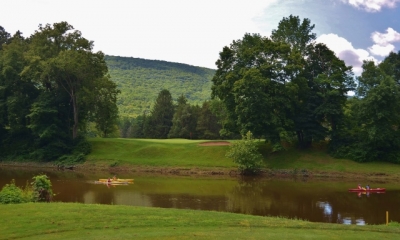 |
| Brave kayakers floated by as we teed off on the par three 2nd hole (Red). |
No, it’s not your in your dreams – it’s reality at the Shawnee Inn and Golf Resort, located along the Delaware River in northeastern Pennsylvania, just across from the New Jersey state line (about two hours from Philadelphia).
24 of Shawnee’s 27 golf holes are situated on an island in the middle of the Delaware, hence the name of the town.
The “golf island” is special enough on its own, but eighteen of Shawnee’s holes (the Red and Blue nines) were designed by legendary golf architect A.W. Tillinghast, and they happened to be his very first design. Everyone gets their start somewhere, and for Tillinghast, he began his career right there alongside the historic Delaware.
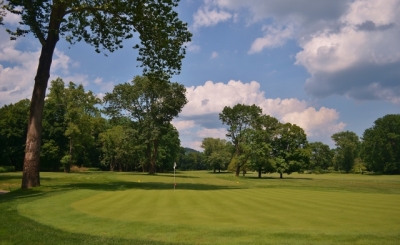 |
| The par five 3rd hole (White) requires accurate and strategic play to avoid the trees. |
The final nine holes (now known as the White nine) were added in the 1960’s by another notable golf course scribe, Bill Diddle. The White nine also offers three par threes, three par fours and three par fives – yet another somewhat rare configuration.
Joe Manley, Shawnee’s Head Golf Professional, takes the story from here. “It’s true that Tillinghast’s first golf design was here, but that’s not the end of it. He came back multiple times over the years as he learned and gained more experience in golf course architecture.”
Manley continues, “Tillinghast came back to tweak different things – greens complexes, bunker complexes… He was very hands-on -- that’s one of the reasons our greens are so unique, because they’re all individually crafted by a master designer.”
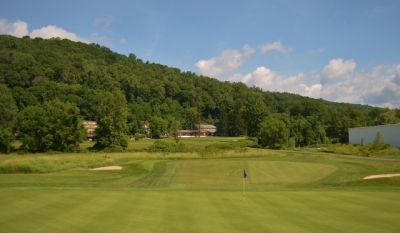 |
| Our favorite green on the entire golf course was the punchbowl on the par three 9th hole (Blue). |
That’s for sure. Shawnee’s putting surfaces have a lot of slope and contour to them, so Manley says they can’t be cut real short for regular resort play. Nothing like slick, sloped greens to guarantee a five or six hour round – and no one wants that on vacation.
Our favorite Tillinghast feature (of many) was the punchbowl green on the long par three ninth hole on the Blue nine. If the pin is located in the “bowl,” shots hit long or to the sides will filter towards the flag. Likewise, on many other holes you can use the green slopes to aim away from the cup and then steer the ball towards it.
It’s golf like it was meant to be.
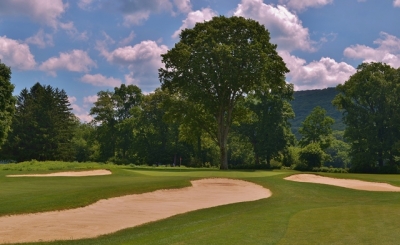 |
| The par five 6th (Red) could be reachable in two, but you will have to navigate between the bunkers to run-it-up. |
Another invention original to the Shawnee Inn helped pioneer golf in the region – and all over the world, really. The resort’s original developer, C.C. Worthington, was an inventor and an engineer. Worthington’s “gang mowers” made cutting fairway grass fast and efficient -- and they were first used on Shawnee’s pristine golf holes.
As alluded to above, the golf island wasn’t complete until celebrity bandleader Fred Waring acquired the property and ordered the final nine holes built (in the 60’s). The original Tillinghast layout was altered slightly during this time, but there are a number of original Tillinghast holes still in existence, including the signature par three, number seven on the Blue nine.
But even in the old days, you still had to play over a branch of the Delaware River to get to the golf island (and back again near the conclusion of the round), and the Shawnee bridge connecting the mainland to the golf course is almost as famous as the resort itself.
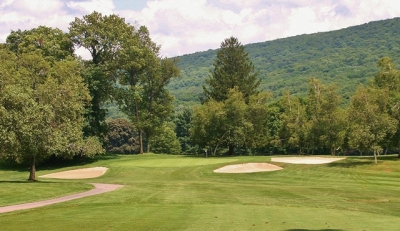 |
| The gentle par three 2nd hole on the White Nine. |
Again looking back, up until the 1960’s, the south end of the island was used as farmland and also contained vacation cottages.
“The Warings had a cottage out there, and there were some other seasonal residents there. There’s one cottage left on the island, and we just use it as a restroom facility and for storage now. But during the early years, people actually lived there,” Manley said.
Waring’s ownership also ushered in what is probably considered the heyday of the Shawnee Inn and Golf Resort, as depicted in the framed black and white photographs on the basement level near the golf shop. A who’s who of the Golden Age of television, film and golf is shown in the pictures, with Jackie Gleason and Arnold Palmer showing up prominently.
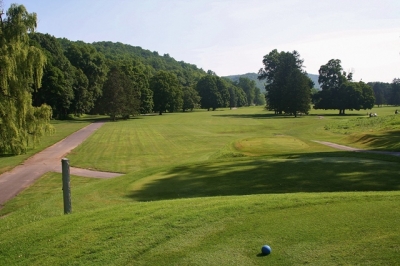 |
| The elevated tee of the par five 6th hole (Blue) allows you to pick your target and let-fly. |
Viewing those photos provides the same sense of history that you get from playing the golf courses – something akin to “it happened here,” a special quality that you don’t get from just any golf course.
The photo collection also depicts another more recent aspect of the Shawnee experience – floods. The Delaware River has flooded four times in the past twenty years, and the mess left behind was a monumental task to clean – both at the Inn itself, and on the golf courses.
For the record, the floods took place in 1996 (after the early January record-breaking snowstorm and subsequent rains), September of 2004, April of 2005 and June of 2006 -- the latter three coming within the span of about 20 months.
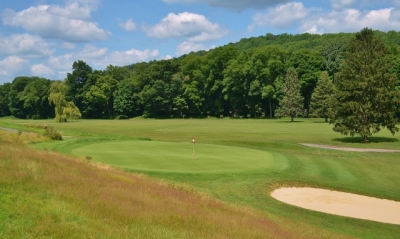 |
| Joe Manley says if you get on the wrong level of the 5th green (Red), you might struggle to two-putt. |
“They were absolutely devastating,” Manley remembers. “But we learned from each one – different techniques to save the golf course, to repair the golf course, to bring the golf course back.”
“In all three of those floods, we only lost one green. We were able to save every single one of the others by getting the mud and silt off very quickly.”
Again, the photos don’t lie. It’s almost beyond comprehension that such a large-scale mess could be cleaned up time and again – without losing the golf course. It’s quite a tribute to Manley and the Shawnee staff in preserving the quality of the golf – and the beauty of the “golf island” along with it.
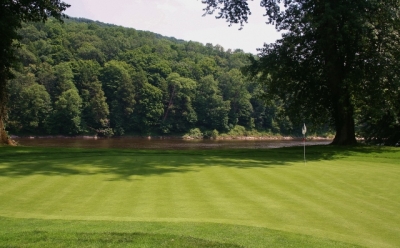 |
| Take a moment when you finish the par three 4th hole (White) to admire the beautiful river views. |
In terms of playing the courses, with mountains all around, you might expect the golf to echo the rugged nature of the surroundings – but not at Shawnee. Manley says they have the flattest links in the area, which helps avoid the dreaded blind shots as well as uneven uphill, downhill and side hill lies that always seem to coincide with mountain golf.
But just because the courses are relatively flat doesn’t mean they’re boring -- or a pushover. The Tillinghast greens complexes protect the course along with numerous large deciduous and pine trees – and thick rough. Hitting out of the rough is definitely a penalty – keep that in mind when selecting clubs off the tee.
One of the nice aspects of playing at Shawnee is the forgiving nature of the courses. Though trees are abundant there, you won’t have much trouble finding your ball, should you miss the short grass. This avoids the inevitable frustration of losing sleeves of balls for those of us who hit one offline now and then.
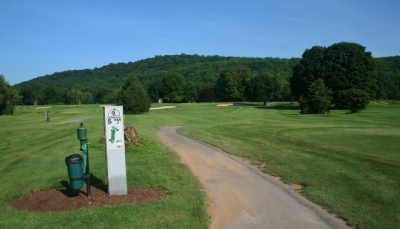 |
| At 211 yards from the back tee, the 5th hole (Blue) is the second longest par three at Shawnee. |
At Shawnee, strategy is often dictated by the layout of the hole, with many dog legs and tight angles to navigate. The courses are demanding without being brutal – the worse penalty you’ll typically incur is a chip out to the fairway if trees block your path.
Wildlife is also a major part of the Shawnee experience, including the presence of a bald eagle’s nest in a pine tree near the tee of the Blue nine’s par five third hole. With such a natural setting, even the critters want to take up residence there.
Manley describes the highlight holes on the Red, White and Blue nines:
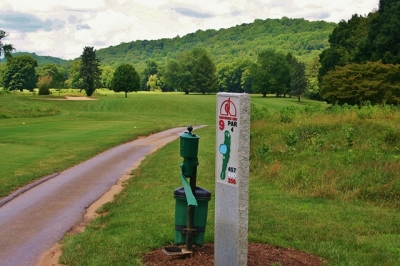 |
| Trouble awaits if you miss the fairway on the par four 9th hole (Red). |
“Number one Red has a pretty a pretty straight-forward tee shot, nothing to worry about there. But then your approach shot has to go over a small creek to a large, relatively flat green. It’s a fair opening hole as long as you can hit the fairway and aren’t overly intimidated by going across that stream.”
“Number nine Red is one of the most challenging holes on the entire golf course, a slightly uphill par four. For your tee ball, you have to avoid the pond on the left, and then if you lose your tee ball right in the rough, you’re going to struggle to get home because there’s a big tree that’s protecting the right side of the green. Then, the hole features a very large green with a couple distinct levels -- so you want to make sure you get on the right one. Par’s a real good score on that one.”
“On the White Nine, the fourth hole is a real good par three. And when you get done playing it, I always advise individuals to – if you’re not holding anybody up – to go look off the backside of that green at the river. You don’t see a home… you don’t see anything besides maybe a kayaker or two. And an eagle. It’s a beautiful picturesque spot on the golf course.”
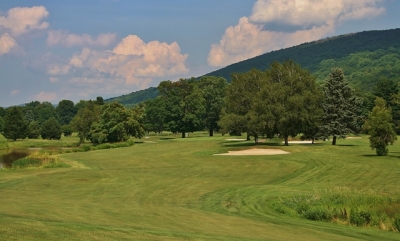 |
| A pond guards the left side of the par four 8th hole (White), but missing right is no bargain, either. |
“Number eight White is a great hole. It’s a par four, slight dogleg to the left. With your tee ball – you can’t just blast off because there’s a pond guarding the left side. And then on the right side is a pretty large bunker that’s there to gobble up tee shots hit in that direction. It’s a pretty tough hole.”
“For the Blue Nine, the dogleg left first hole is one of my favorites on the golf course. On the tee ball, you have to watch out for the pond on the left, but there is room to the right. The real challenge is on that green, which is pretty large and slopes right to left. If you miss the ball right, you’re going to be in kind of a narrow bunker. And if the pin is on the right and you’re in that bunker, you don’t have much of a chance of getting it up and down.”
“Finally, the signature hole on the entire golf course is Blue number seven, which has the tee shot over the river -- it’s the prettiest hole on the golf course. It’s a great hole from the back tee, probably about 180 yards. You’re basically coming out of a chute from back there, very intimidating. The green has a little bit of a false front, so if you put any spin on the ball, you can spin it off the green into the rough.”
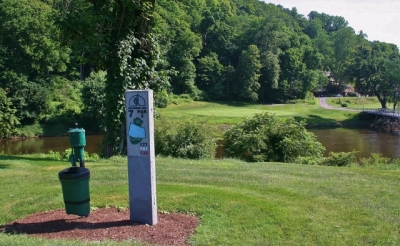 |
| The signature par three 7th hole (Blue) requires a carry over the Delaware River from all tee boxes. |
As if the 27 holes weren’t enough, the Shawnee Resort also offers a six-hole “short” course designed by Tom Doak. The holes were built to enhance the Shawnee Golf Academy, but resort guests can also use them (and they’re night-lighted).
Not a bad place to practice your short game, as the bunkers are large and the greens are sloped, just as Tillinghast would have made them.
It’s true that Shawnee is a destination resort, and it’s been around for over a hundred years -- but it’s a golf course that never gets old. “I want our players to leave thinking it’s a golf course they could play every day and not get tired of it. I get that – every time I play here, it’s never boring. It’s just a fun, enjoyable round of golf from scratch golfers to high handicappers,” Manley concluded thoughtfully.
If you’re a fan of classic golf architecture to be enjoyed in a beautiful, historic, relaxing, natural setting, then the Shawnee Inn and Golf Resort – and the “golf island” -- should be high up on your to-do list.
Click here for a look at the history of the Shawnee Inn.
Details:
The Shawnee Inn and Golf Resort
One River Road
100 Shawnee Inn Drive
Shawnee on Delaware, Pennsylvania 18356
Phone: 800 SHAWNEE
Tee Times: 570-213-5060
Website: www.ShawneeInn.com
Course designers: A.W. Tillinghast and Bill Diddle
Head Golf Professional: Joe Manley
Tees/Yardage – Blue Nine
Blue 3438
White 3227
Yellow 2957
Red 2812
Tees/Yardage – Red Nine
Blue 3362
White 3063
Yellow 2922
Red 2838
Tees/Yardage – White Nine
Blue 3227
White 3023
Yellow 2867
Red 2586
Slope/Rating -- Blue/Red 18
Blue 126/72.0
White 124/70.2
Yellow 120/68.2
Red 124/71.9
Slope/Rating – Red/White 18
Blue 123/71.5
White 122/69.7
Yellow 119/68.2
Red 122/70.9
Slope/Rating – White/Blue 18
Blue 128/71.8
White 127/70.3
Yellow 123/68.2
Red 122/70.6
Rates:
The resort guest rates are $50 during the week and $70 on the weekends. Shawnee offers lots of stay and play packages, and they change very frequently. Check the website.
Note: For practical reasons, all guests must take carts. Members may walk in some circumstances.
| Related Links | Comments on this article? | |
|
Maryland National Golf Club Hollow Creek Golf Club Rocky Gap Resort PB Dye Golf Club in Ijamsville Whiskey Creek Golf Club |
E-mail Jeff Rendall, Editor: jrendall@golftheunitedstates.com |











